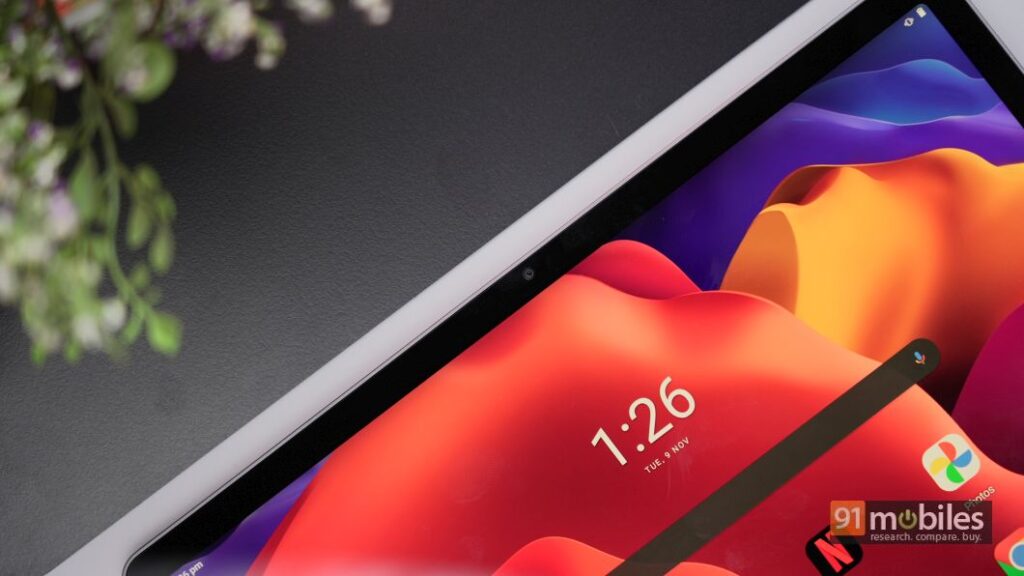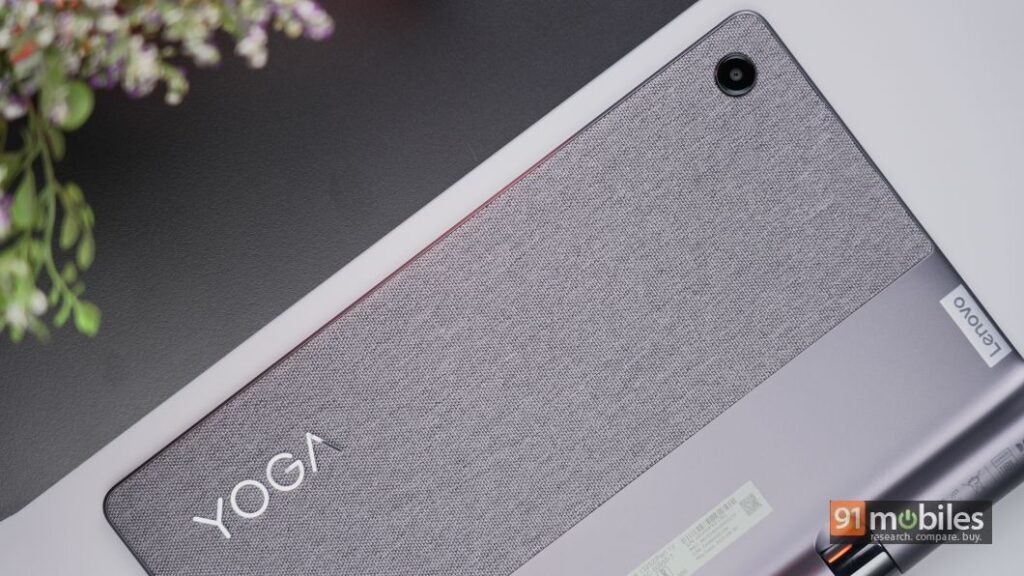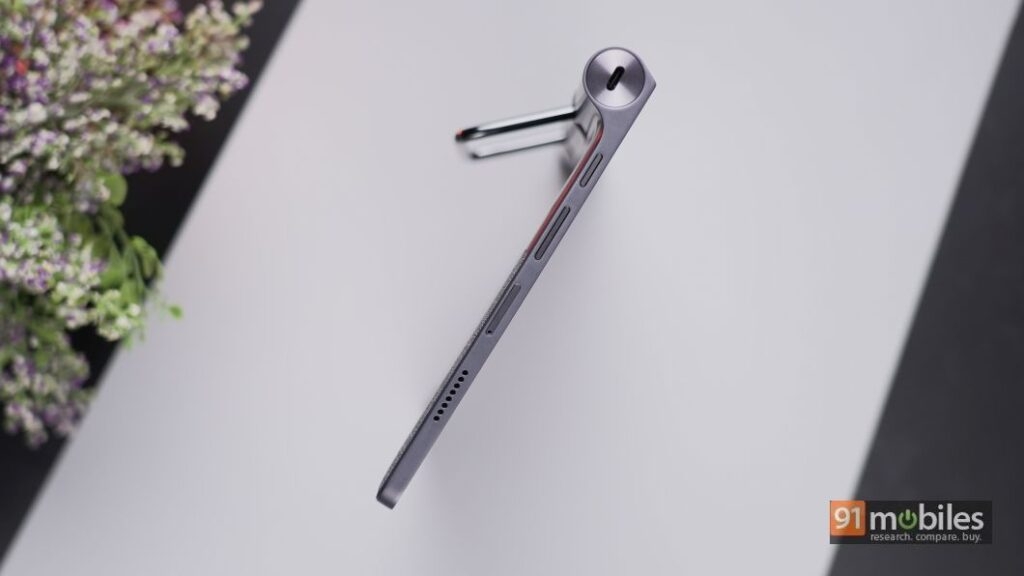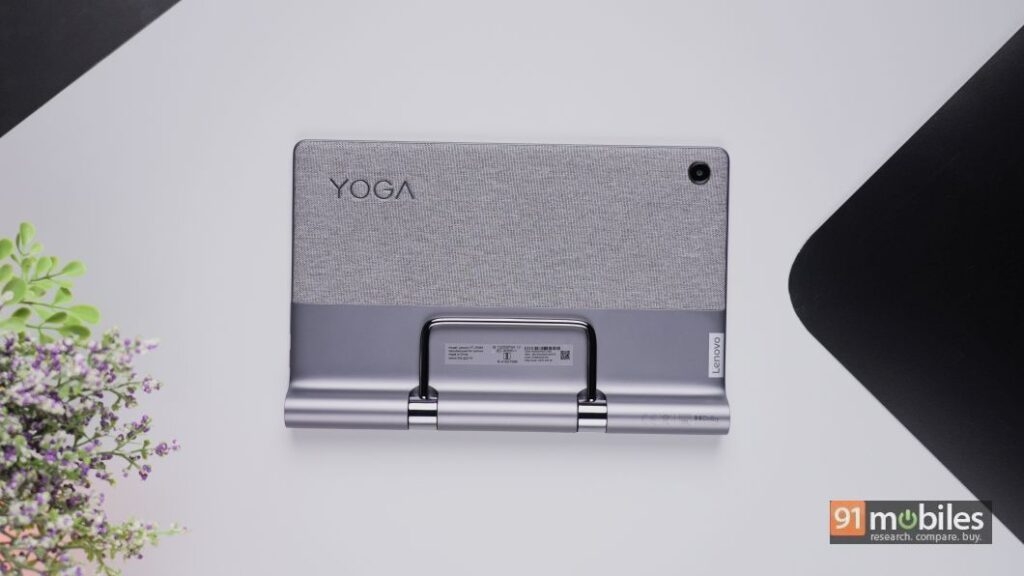Those looking for a brand-new tablet usually resort to getting the latest model from either Apple or Samsung. What’s more, in an attempt to rope in budget-conscious buyers, both the brands now offer VFM tablets too. As such, it’s hard to overlook the Apple-Samsung duopoly in the tablet segment, though that hasn’t deterred Lenovo’s spirits. In fact, coming after the launch of the premium Tab P11 Pro (review), the brand has unveiled a wallet-friendly tablet in the form of the Lenovo Yoga Tab 11. I managed to get my hands on a unit and here’s what I make of it.
Design
The Lenovo Yoga Tab 11’s design is a double-edged sword. On one hand, at 650 grams, the unit isn’t as sleek or lightweight as some other competing 11-inch tablets. On the flip side, the device offers a fantastic, built-in, metallic kickstand that can be used to position the Tab 11 seamlessly on a flat surface. What’s more, the kickstand is complimented by a rather sturdy hinge that offers ample friction as well as a rubberised bushing, thereby ensuring the tablet stays put even when you’re tapping on the screen.

Now, having used the tablet for the better part of a week, I’ll admit, I’ve come to like the kickstand quite a bit. You see, the kickstand allows me to holster the tablet near my monitor and in doing so, I can use the unit’s display as a secondary screen for all my media consumption needs. What’s more, I don’t have to jerry-rig the tablet to stand upright either. It also helps that the tablet doesn’t budge when I am taking video calls and while I haven’t tested the waters by using the device in a crowded metro, I am confident that the articulating kickstand will offer a much superior in-hand grip as opposed to a flimsy case.

Ergonomics aside, Lenovo has left no stone unturned in designing the Yoga Tab 11, and the unit offers a premium fit and finish as well. To that note, the tablet has been constructed in its entirety using metal, and the chassis doesn’t flex or give no matter how you grip the device. What’s more, the back of the tablet employs a woven fabric finish that doesn’t just accentuate the device’s overall looks but also betters a user’s in-hand feel. Now, much to my dismay, the tablet doesn’t ship with a fingerprint sensor. However, the unit’s facial recognition tech worked quite well during my stint with the device.

As for the I/O, the Yoga Tab 11 ships with a clicky power button and volume rocker on its right-hand spine. Interestingly, the cylindrical bulge at the bottom houses a slew of hardware components too, including two speaker units and a USB Type-C port for charging the device. The tablet ships with two more speaker drivers positioned on either side of its frame, along with a dual-mic array that sits up top. Unfortunately, the device doesn’t ship with a 3.5mm jack which is baffling when you consider the tablet’s girth and size. But, I digress.
Display and Audio
Lenovo hit the ball out of the ballpark with the Tab P11 Pro’s OLED display. Unfortunately, the Yoga Tab 11 gets an IPS LCD panel, though the screen is still plenty good for watching movies on the fly. Spec-wise, the tablet ships with an 11-inch, 2,000 x 1,200 pixels 2K panel that offers a peak brightness of 400 nits. Furthermore, the tablet does come with Widevine L1 certification, thereby ensuring users can stream their favourite TV shows and movies in HD from various OTT services. That said, while I could relay HDR media via YouTube, the tablet doesn’t support HDR playback from Netflix, which is a bummer. Interestingly, the tablet does support Dolby Vision, so HDR streaming might be possible with a software patch down the line. On the bright side, the display offers good viewing angles and is bordered by sleek bezels too. What’s more, unlike most LCD screens, the Yoga Tab 11’s display does justice to darker hues too, which is nice.

Do note that the display is capped at 60Hz, so you might take a while to acclimate to the device’s UI animations and transitions. Thankfully, the panel’s touch response rate was to my liking and the display managed to pick up on all my swipes and gestures seamlessly. Rest assured, BGMI enthusiasts longing for a tablet with decent performance and a responsive screen will find plenty to like here. Moving on, the display’s palm rejection isn’t the best, however, you can grip the device by holding the kickstand to avoid any accidental touches.

Much to my dismay, the Lenovo Yoga Tab 11 omits a headphone jack. Now, the unit somewhat makes up for the omission by offering a JBL-backed quad-speaker array, that gets plenty loud for watching movies on the fly. Regardless, movie and audio buffs will certainly raise an eyebrow when they look at the Tab 11’s spec sheet.
Performance and Software
The Lenovo Yoga Tab 11 is backed by MediaTek’s Helio G90T processor which works alongside LPDDR4x memory and UFS 2.1 storage. For the uninitiated, the SoC was launched a while back and at the time, was a compelling mid-range chipset that could drive resource-hungry games and apps effortlessly. It goes without saying that the chipset’s performance isn’t exemplary by today’s standards, but the Yoga Tab 11 can still hold its own in the performance department.

Let’s start with gaming and here, the Yoga Tab 11 can run graphically-demanding games like BGMI at modest settings. To that note, the tablet can run the game at HD graphics preset and High frame rate preset. Unfortunately, despite lowering the graphics to the ‘Smooth’ preset, the tablet will still cap your gameplay to 45fps or the ‘Ultra’ setting. Thankfully, the device didn’t exhibit any major frame drops whilst running the title and the device’s temps didn’t spike unnaturally either.

The day-to-day performance of the tablet doesn’t disappoint either. In fact, the unit could comfortably keep half a dozen apps in memory, the likes of which include YouTube, Netflix, etc. Now, the experience of jumping from one app to the other leaves a little to be desired, and the UI animations appear a tad stutter-y at times. Barring that, the tablet didn’t show any major signs of struggles when I was using it day in and day out. Moreover, the unit’s 7,700mAh cell ensured I only had to top up the device every other day. Rest assured, the Tab 11 will outlast your longest binge sessions without breaking a sweat.

As for software, the Lenovo Yoga Tab 11 ships with Android 11 out of the box. The interface is fairly stock, and you also get Google’s Kid Space and Entertainment hub which aggregates all your favourite TV shows and movies in one place, ensuring you don’t have to hop from one app to the other to find something to watch. The tablet also comes with support for the company’s Precision Pen 2, however, you’ll have to purchase that separately.
Verdict
The Lenovo Yoga Tab 11 costs Rs 40K, but those eyeing the tablet can pick it up for around Rs 30K from e-commerce portals like Amazon. For its discounted price, the Yoga Tab 11 brings a lot to the table, including a high-res display and a competent SoC. That said, platform-agnostic users could find better value in the new 10.5-inch iPad, which retails for the same price albeit offers a faster chipset and a more cohesive interface. Regardless, if you are on the lookout for a VFM Android tablet, then you’ll find little to dislike about Lenovo’s latest offering.
Editor’s rating: 3.5 / 5
Pros:
- Stylish, functional design
- High-res display and loud speakers
- Long-lasting battery life
Cons:
- No headphone jack
- Lacks fingerprint sensor
- Cannot relay HDR media from Netflix
The post Lenovo Yoga Tab 11 review: some hits, a few misses first appeared on 91mobiles.com.
via ©91 Mobiles









No comments:
Post a Comment